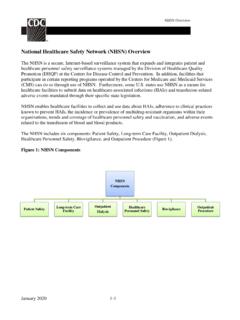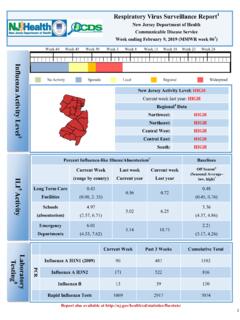Transcription of Chapter 7: Measles
1 VPD surveillance ManualMeasles: Chapter 7: MeaslesPaul A. Gastanaduy, MD, MPH; Susan B. Redd; Nakia S. Clemmons, MPH; Adria D. Lee, MSPH; Carole J. Hickman, PhD; Paul A. Rota, PhD; Manisha Patel, MD, MS I. Disease DescriptionMeasles is an acute viral illness caused by a virus in the family paramyxovirus, genus Morbillivirus. Measles is characterized by a prodrome of fever (as high as 105 F) and malaise, cough, coryza, and conjunctivitis, followed by a maculopapular The rash spreads from head to trunk to lower extremities. Measles is usually a mild or moderately severe illness. However, Measles can result in complications such as pneumonia, encephalitis, and death. Approximately one case of encephalitis2 and two to three deaths may occur for every 1,000 reported Measles rare long-term sequelae of Measles virus infection is subacute sclerosing panencephalitis (SSPE), a fatal disease of the central nervous system that generally develops 7 10 years after infection.
2 Among persons who contracted Measles during the resurgence in the United States ( ) in 1989 1991, the risk of SSPE was estimated to be 7 11 cases/100,000 cases of The risk of developing SSPE may be higher when Measles occurs prior to the second year of average incubation period for Measles is 11 12 days,5 and the average interval between exposure and rash onset is 14 days, with a range of 7 21 , 6 Persons with Measles are usually considered infectious from four days before until four days after onset of rash with the rash onset being considered as day zero. II. BackgroundEpidemiology of Measles in the United StatesPre-elimination eraIn the decade prior to the licensure of live Measles vaccine in 1963, an average of 549,000 Measles cases and 495 Measles deaths were reported However, almost every American was affected by Measles during their lifetime, and it is estimated that 3 4 million Measles cases occurred each , 9 Following implementation of a one dose Measles vaccine program, there was a rapid and significant reduction in the reported incidence of Measles in the United States through the 1980s,10 resulting in declines in Measles -related hospitalizations and By the late 1980s, however, Measles outbreaks were still occurring among school-aged children who had received a single dose of Measles vaccine.
3 In 1989, a second-dose vaccination schedule was recommended by the Advisory Committee on Immunization Practices (ACIP), the American Academy of Pediatrics (AAP), and the American Academy of Family Physicians (AAFP).11 During 1989 1991, a resurgence of Measles occurred when over 55,000 cases and 123 deaths were reported. The epidemiology during the resurgence was characterized mainly by cases in preschool-aged children living in poor urban areas who had not been vaccinated on time with one dose of Measles Following the resurgence, a commitment of resources for improved implementation of the timely administration of the first dose of the vaccine, and increased implementation of two doses among school-aged children, led to further declines in Measles cases. In 2000, endemic Measles was declared eliminated1 from the United Elimination is defined as the absence of endemic Measles cases for a period of 12 months or more, in the presence of adequate surveillance (World Health Organization) VPD surveillance ManualMeasles: Chapter eraDuring 2001 2008, 557 Measles cases were reported in the United , 15 The median number of Measles cases reported per year was 56 (range: 37 140 cases/year).
4 The majority of US-resident case-patients were unvaccinated (66%) or had unknown vaccination status (16%). Of the 557 reported Measles cases, 232 (42%) were importations (median of 26 importations/year). In comparison, during 2009 2014, 1,264 Measles cases were reported in the United States. The median number of Measles cases reported per year was 130 (range: 55 667 cases/year). The majority of US-resident case-patients were unvaccinated (74%) or had unknown vaccination status (16%). Of the 1,264 reported Measles cases, 275 (22%) were importations (median of 45 importations/year). Among the 989 US-acquired cases reported during 2009 2014, 673 (68%) were epidemiologically linked to these importations, 256 (26%) either had virologic evidence of importation or had been linked to those cases with virologic evidence of importation, and 60 (6%) had unknown source. Unknown source cases represent cases where epidemiologic or virologic link to an imported case was not detected.
5 Measles incidence has remained below one case per million since 1997, except in 2014, when 667 Measles cases were reported, representing a reported incidence of cases per The epidemiology of Measles in 2014 was characterized by (1) a high proportion (92%) of cases among residents who were unvaccinated or who had unknown vaccination status and (2) more spread from imported cases than in other years. In 2015, 191 Measles cases were reported; 28 (15%) were importations, and 142 (80%) of 178 cases among residents were unvaccinated or had an unknown vaccination status. In recent years, most of the importations were the result of unvaccinated travelers who had traveled to Measles endemic countries, including countries in the World Health Organization (WHO) European and Western Pacific Measles elimination has been achieved in the United States, importation of Measles will continue to occur as Measles remains endemic in many other parts of the world.
6 Thus, current Measles epidemiology in the United States is determined by characteristics of the imported cases and their susceptible contacts. Measles outbreaks in the United States in the post-elimination eraFrom 2001 through 2008, 38 outbreaks2 of Measles were reported (annual median no. of outbreaks, 4 [range, 2 10 outbreaks]); outbreaks had a median size of four cases (range: 3 34).14 From 2009 through 2014, 66 outbreaks of Measles were reported (annual median no. of outbreaks, 10 [range, 4 23 outbreaks]); outbreaks had a median size of 5 cases (range: 3 383).14 Outbreaks of Measles in the United States mostly involve individuals who are directly exposed to imported Measles cases or who are infected during a resulting chain of transmission, and who are either unvaccinated or had unknown vaccine status. The settings of Measles transmission have included households, educational institutions ( , schools, day care), churches, health care facilities, homeless shelters, and other congregate settings.
7 Lack of adherence to existing recommendations for Measles prevention among groups at high risk (for example, individuals who travel internationally), can spread Measles to susceptible populations, including infants too young to be vaccinated and unvaccinated persons by , 17 Because of high population immunity, high Measles vaccine effectiveness, and the immediate implementation of control measures, generally the sizes of Measles outbreaks in the United States are limited. However, recent large outbreaks emphasize the importance of maintaining high levels of Measles immunity across the population through routine Measles vaccine coverage. The largest Measles outbreak documented in the United States in more than two decades (383 cases) occurred in an under-immunized Amish community in Ohio over 4 months (March July) i n From December 2014 through March 2015, a Measles outbreak consisting of 147 cases that originated in Disney theme parks in California spread to seven other states and two neighboring , 20 Responding to Measles cases and outbreaks is time consuming and costly for local and state health , 22 The overall costs to health departments to contain 16 outbreaks during 2011 amounted to an estimated $ million to $ million dollars.
8 The economic burden of controlling Measles spread in health care settings amounts to an estimated $19,000 to $114,286 dollars per case. 2 National reporting: An outbreak is defined as a chain of transmission including 3 or more cases linked in time and surveillance ManualMeasles: Chapter measlesDespite tremendous achievements towards global Measles mortality reduction and elimination goals, globally, in 2015, there were 254,928 Measles cases reported and an estimated 134,200 Measles deaths ( , approximately 367 deaths/day).23 During 2015, Measles outbreaks were reported in several countries in the African, European, and Eastern Mediterranean In the Americas, under the leadership of the Pan American Health Organization (PAHO), Ministries of Health implemented an aggressive Measles elimination program in 1994. By 2002, scientific evidence suggested that endemic transmission of Measles virus in the Americas was interrupted for 12 months, 24 however, imported cases from endemic areas of the world continued to occur, resulting in sizable outbreaks in several countries, including Ecuador, Canada, and the United States.
9 More recently, a large Measles outbreak in Brazil, with sustained transmission lasting over a year, ended in July In September 2016, after over two decades of commitments and efforts by Member States to control Measles , the Region of the Americas was the first in the world to verify the elimination of measures are also underway to achieve Measles elimination in other regions. Countries in all six WHO regions have adopted Measles elimination goals, and four WHO regions endorsed the Global Vaccine Action Plan to eliminate Measles by 2015; although these elimination goals were not accomplished. The Global Vaccine Action Plan has also set a target for Measles elimination in five WHO regions by Achieving elimination in other regions of the world will have direct benefits in the United States. III. Maintenance of EliminationThe declaration of endemic Measles elimination in the United States was made in , 13 The key challenges to maintaining the elimination of Measles from the United States are vaccinating children at age 12 15 months with a first dose of Measles , mumps, rubella (MMR) vaccine; ensuring that school-age children receive a second dose of MMR vaccine; vaccinating high-risk groups, such as health care personnel and international travelers including infants 6 to 11 months of age; maintaining Measles awareness among health care personnel and the public; and working with Government agencies and international agencies, including the WHO, on global Measles mortality reduction and elimination goals.
10 In addition, pockets of unvaccinated populations can pose a risk to maintaining , 26 Thus, rapid detection of cases is necessary so that appropriate control measures can be quickly implemented. This is to prevent imported strains of Measles virus from establishing endemic chains of transmission. Outbreak preparedness and response remains one of the five core strategies in the 2012 2020 WHO strategic plan for global Measles and IV. Vaccination Live attenuated Measles virus vaccine is incorporated into combination MMR vaccine and combination Measles , mumps, rubella, and varicella (MMRV) vaccines. Monovalent Measles vaccine is not available in the United States. For prevention of Measles , two doses of MMR vaccine are recommended routinely for children, with the first dose at age 12 through 15 months and the second dose at ages four through six years (school entry).28 For prevention of Measles among adults, two doses of MMR vaccine are also recommended for adults at high risk, including international travelers, college and other post-high school students, and health care personnel born during or after All other adults, born during or after 1957, without other presumptive evidence of Measles immunity, should be vaccinated with one dose of MMR recommendations for an outbreak setting are discussed in the Control Measures section in this Chapter .

















